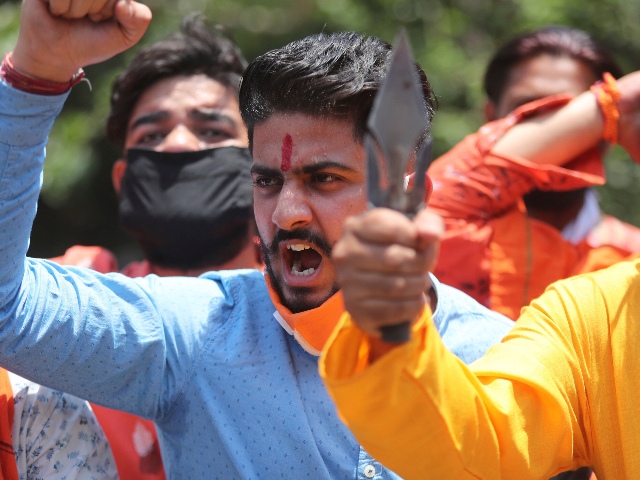Chinese troops from the People’s Liberation Army (PLA) viciously attacked Indian soldiers stationed along the Galwan River Valley in India’s northeastern Ladakh state on Monday night for over eight hours, killing at least 23 Indian soldiers, India’s News18 reported.
PLA “death squads” armed with “batons wrapped in barbed wire” and iron rods “hunted down and slaughtered” Indian troops of the 16 Bihar Regiment, a senior Indian government official familiar with the debriefing of survivors of the attack allegedly told News18.
The Chinese communist regime has not denied the account or offered any significant details, including the number of casualties on the Chinese side.
The regiment’s commanding officer, Colonel Santosh Babu, was killed in the “savage” hand-to-hand combat, the Indian Army confirmed late Tuesday. Colonel Babu died after he “was pushed from [a] narrow ridge and fell to his death in the gorge below,” the Guardian reports.
Many others on the Indian side died “because of protracted exposure to sub-zero temperatures” in the icy, high altitude terrain in the western Himalayas, the Indian Army said.
“Even unarmed men who fled into the hillsides were hunted down and killed,” one unnamed Indian officer is quoted as saying. “The dead include men who jumped into the Galwan River in a desperate effort to escape.”
According to government sources, at least another two dozen soldiers are battling “life-threatening” injuries at hospitals in Ladakh’s capital, Leh; over 110 soldiers have needed treatment for injuries sustained during the attack.
“The [Indian death] toll will likely go up,” an Indian military officer with knowledge of the matter told News18.
According to the report, the fighting in Galwan Valley began after Colonel Babu commanded his troops over the weekend to dismantle a Chinese tent set up near a position known as Patrol Point 14, located near the mouth of the Galwan River. A different Chinese tent at the site had previously been dismantled after the action was agreed to during a meeting between Indian Lieutenant General Harinder Singh, who commands a Leh-based military unit, and Major-General Lin Liu, the head of China’s Xinjiang military district.
However, just two days after the meeting, the PLA set up a new tent at Patrol Point 14, inside territory claimed by India. Government sources say Colonel Babu’s regiment was then ordered to “ensure the [new] tent was removed.” The PLA refused to vacate Point 14, breaking a June 6 agreement between both sides to deescalate their ongoing border dispute in the area. According to sources, this refusal led to an ensuing “melee” during which the new Chinese tent was burned down.
After the tent was burned, the PLA began pelting Indian soldiers with stones on Sunday, according to the report. This escalated on Monday when the PLA launched a “massive” overnight attack on the Indian regiment’s troops. Chinese soldiers dropped “large rocks” onto Indian troops stationed on a “high ridge above Point 14,” one source said. Some Indian troops reportedly fought back using “improvised weapons,” but most had no significant means of defense. Per decades of tradition in the Galwan Valley, neither side is armed. This is meant to “ward off the possibility of escalation between the nuclear-armed neighbors,” according to the Guardian.
According to Indian government sources, the PLA claims that India is responsible for Monday night’s assault, alleging that Colonel Babu’s troops “crossed a buffer zone” between the two countries, violating border-management protocols which require the use of “white flags and banners” to signal to forces on the opposite side of the boundary that they must “turn back from the territory [they are] on.”
Indian military officials told News18 that the PLA handed over “large numbers of dead bodies” to the Indian side on Monday morning. The sources add that these casualties may have been “[Indian] men dragged away [by the PLA] in the course of hand-to-hand fighting, and then killed.”
Monday night’s massacre marks the Indian Army’s worst losses since India’s 1999 Kargil War with Pakistan. It is also the most intense fighting recorded between India and China since 1967, when 88 Indian soldiers and about 340 PLA troops were killed during brutal skirmishes near the Nathu La and Cho La mountain passes.
According to News18, the Indian Army says it has “intercepted military communication” suggesting over 40 PLA soldiers were also killed or injured on Monday night, although this has yet to be confirmed.
On Tuesday evening, the Indian Army issued a statement that said that the Indian and Chinese troops in Galwan “have disengaged” from combat, the Hindustan Times reported.
In a video address on Wednesday, Indian Prime Minister Narendra Modi led the nation in two-minutes of silence to honor the fallen soldiers. He then gave his first public comments on the massacre, saying India would “defend every stone, every inch of its territory.”
“I would like to assure the nation that the sacrifice of our jawans [troops] will not be in vain. For us, the unity and sovereignty of the country is the most important,” Modi said.
Modi’s counterpart, Chinese dictator Xi Jinping, has not publicly remarked on the incident.

COMMENTS
Please let us know if you're having issues with commenting.